1983 Half Dollar Coin Value: How Much Is It Worth?
The 1983 Half Dollar is a Kennedy Half Dollar. They were first minted in 1964, a few weeks after JFK’s assassination. He was the 35th President of the United States and is still among the most beloved. Since $1 coins rarely circulate, the Half Dollar is the largest and heaviest coin used in everyday transactions. Let’s learn more and confirm the 1983 Half Dollar Value.
1983 Half Dollar Value Chart (Business Strike) |
||||||||
| Mint Mark | AU 55 | MS 60 | MS 62 | MS 64 | MS 65 | MS 66 | MS 67 | MS 68 |
| 1983-P Half Dollar Value | $1 | $5 | $7 | $10 | $26 | $55 | $600 | $4,000 |
| 1983-D Half Dollar Value | $1 | $5 | $7 | $10 | $28 | $45 | $450 | $4,500 |
1983 Proof Half Dollar Value Chart |
||||||||
| Mint Mark | PR/PF 60 | PR/PF 63 | PR/PF 65 | PR/PF 66 | PR/PF 67 | PR/PF 68 | PR/PF 69 | PR/PF 70 |
| 1983-S Proof Half Dollar Value | $2 | $3 | $5 | $6 | $7 | $8 | $16 | $50 |
1983 Half Dollar Value Guide
A coin has a face value i.e. denomination, and a melt value based on the molten price of its metal content. Its resale value depends on rarity, mint marks, and condition, determined by grading companies e.g. ANACS (American Numismatic Association Certification Service), NGC (Numismatic Guaranty Company), and PCGS (Professional Coin Grading Service).
These grading companies use variations of the Sheldon Grading Scale that goes from 1 to 70. The coins can be collector’s coins e.g. Proof Coins, Uncirculated Sets, Enhanced Circulated Sets and Special Mint Sets. Or they can be regular coins aka business strikes or circulation strikes. Business strikes are graded from PO 1 to MS 70. Proofs are either graded PR or PF.
And regular strikes that resemble proof coins might be graded PL for Proof-Like, DPL for Deep-Proof-Like, or DMPL for Deep-Mirror-Proof-Like. Special Strikes are graded SMS or SP. The 1983 Half Dollar was struck in Philadelphia, Denver, and San Francisco, with the San Francisco coins as mirror-like proofs. No SMS/SP Half Dollars were struck in 1983.
1983-P Half Dollar Value
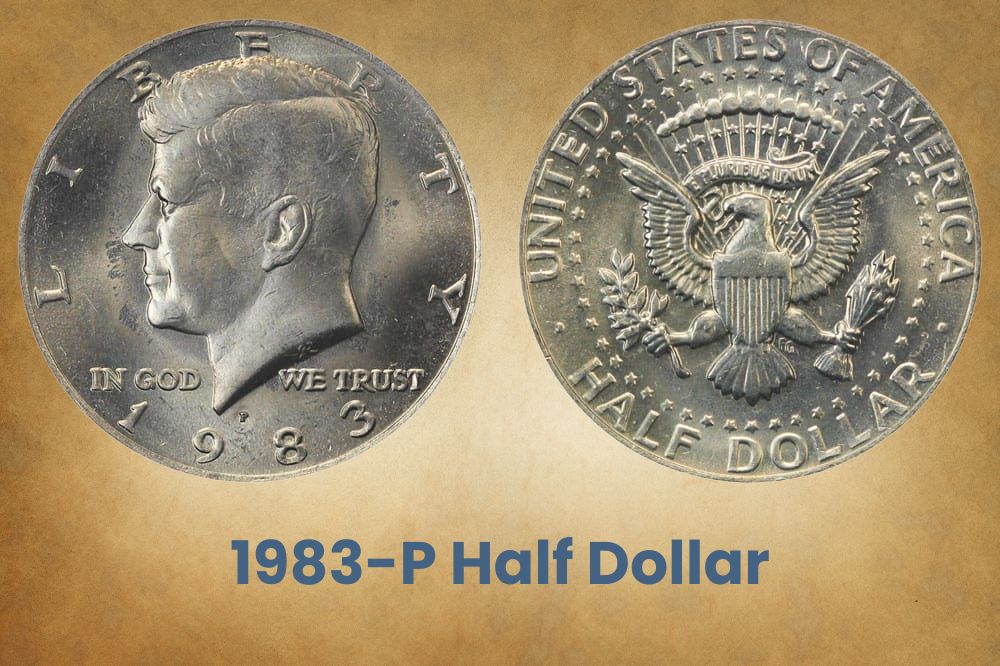
In 1983, the Philadelphia Mint made 34,139,000 Half Dollars with the P Mint Mark. In April 2010, an MS 66 sold for $805. In November 2019, that was down to $106 and in December 2019, it dropped again to $44. PCGS has graded almost 150 Half Dollars as MS 66. As for MS 67, a PCGS-graded coin was $793 in October 2016 but it dropped to $360 in November 2017.
But MS 67 Half Dollars graded by NGC were cheaper. One sold for $155 in July 2022 and another for $95 in September 2022. That said, MS 67+ and MS 68+ 1983 Half Dollars are rare. So far, PCGS has only graded one of each and neither coin has hit the open market yet. In 2023, the PCGS estimates their value as $875 for the MS 67+ and $4,000 for the MS 68.
1983-D Half Dollar Value
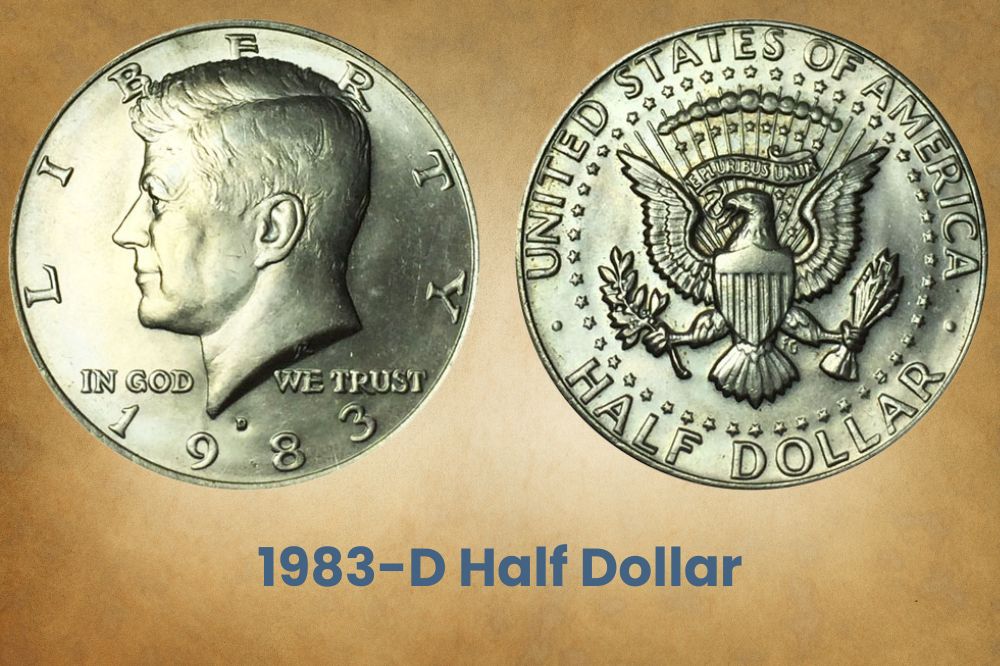
1983 saw 32,472,244 Half Dollars coined at the Denver Mint, all with the D Mint Mark. So far, PCGS has only graded one 1983 MS 68 Half Dollar. It sold for $4,230 in January 2016 and its estimated value is $4,500 in 2023. Half a step below, PCGS has graded almost 20 coins and places their current value at $1,350 though none of these coins has been sold yet.
In MS 67, close to 50 coins are known, and the PCGS Price Guide places their value at $450 in 2023. The most recent sales earned $336 in September 2016 and $353 in September 2016. But an NGC-graded MS 67 sold for much less, at $192 in November 2018. MS 66 coins are easier to find, with over 200 graded so far. But an MS 66 only sold for $49 in January 2017.
1983-S Half Dollar Value (Proof)
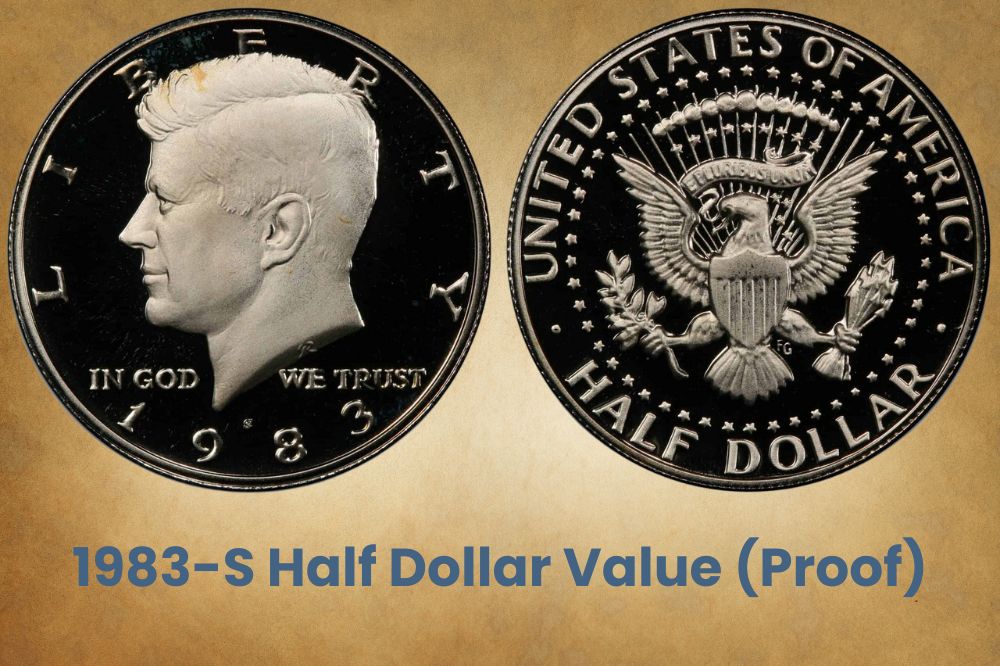
The San Francisco Mint made 3,279,126 Proof Half Dollars in 1983 with the S Mint mark. These proof coins were mirror-like, with a reflective field and a frosted device. Since 1971, this frosting was done with computerized lasers that gave all proof coins that Deep Cameo or Ultra Cameo contrast. For earlier acid-frosted coins, only the first 100 or so were DCAMs.
To make the coins extra shiny, proof dies are polished with horsehair brushes and proof planchets are burnished before striking. The mint tumbles the planchets in vats full of 6mm stainless steel balls called satellites. In January 2008, a PR 70 DCAM sold for $546. In July 2022, it was down to $65. PCGS has graded over 1,000 samples. The 2023 estimate is $50.
In comparison, PCGS has graded more than 11,000 coins as PR 69 DCAM. So while it’s only one step down, the high population has a drastic effect on resale prices. The rarer a coin is, the better its investment value, especially in high grades. That’s why PR 69 DCAM only sold for $25 in April 2018, and the 2023 estimate for 1983 Half Dollars graded PR 69 is just $16.
Related Posts: 26 Most Valuable Half Dollar Coins In Circulation
1983 Half Dollar Errors
When coins exit the coin press, mint workers inspect a few random coins from every batch to check for errors. These flawed coins are melted down and struck afresh. But sometimes, an error coin can slip into circulation, where it resells far above its face value. Mint mistakes can include doubling, tripling, multi-strikes, misalignment, and RPMs (re-punched mint marks).
1983-P Half Dollar Double Struck with Obverse Indent
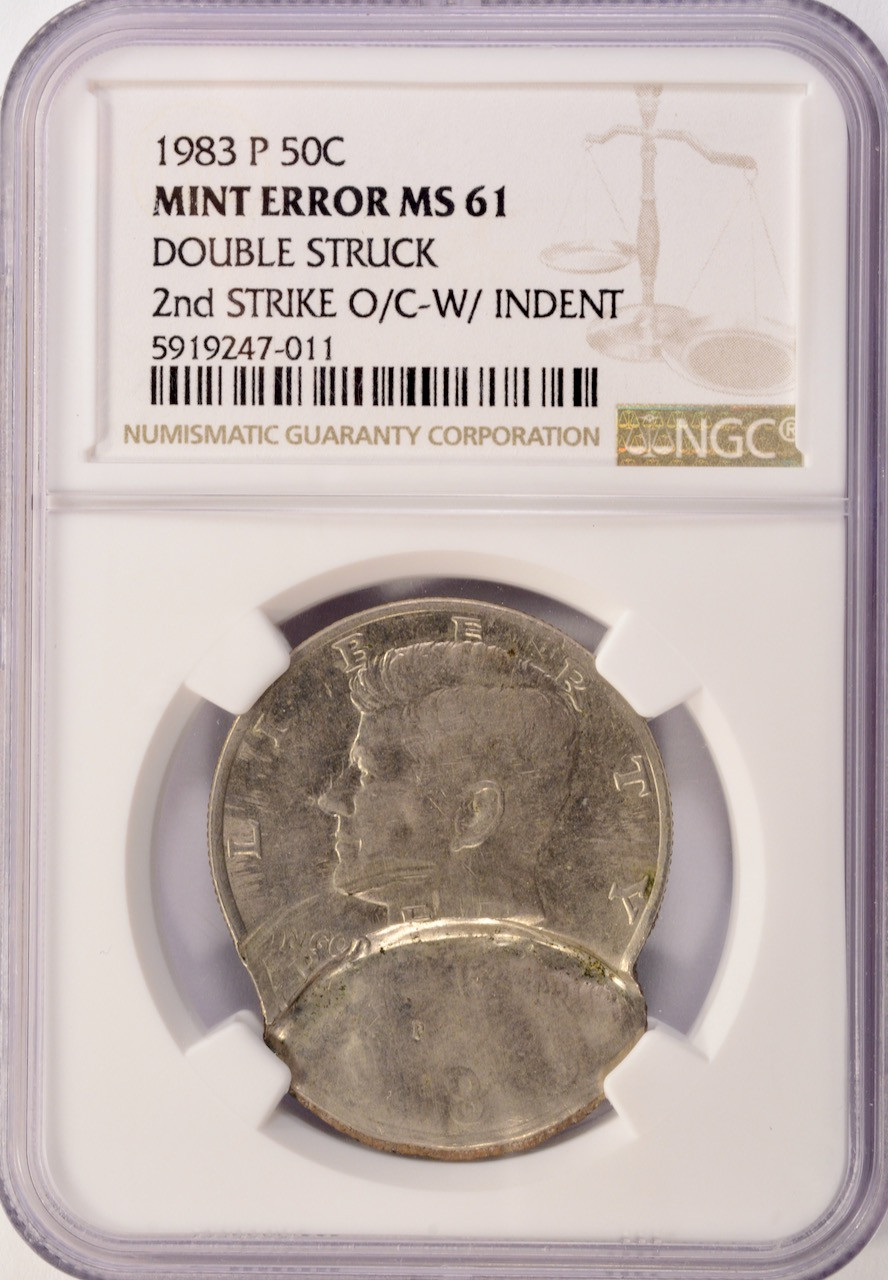
This coin actually has three errors. It was double-struck while exiting the coin press, causing some doubling on Liberty and Half Dollar. The 2nd strike spilled the metal out of its collar, which is called a broadstrike, so the broadstruck section is thinner and flatter. The obverse got dented on the date and on the reverse, copper is exposed on the rim. In MS 66, it’s $800.
1983-P Half Dollar Off-Centre Error
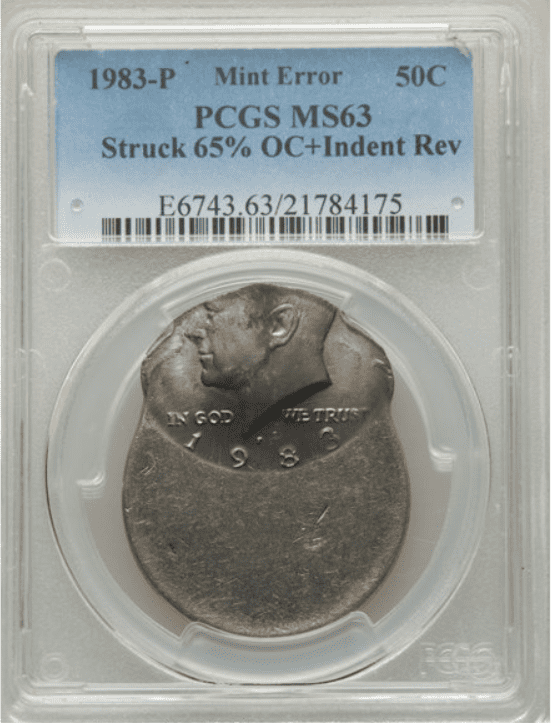
For this coin, the planchet wobbled before the first die strike, so the upper part of the obverse and the lower part of the reverse were left blank. Part of the inner copper core is exposed on the reverse as well. You can differentiate it from a broadstrike because while the rim is wider, it isn’t flatter or thinner, which a broadstrike would be. It sold for $130 on eBay.
1983-P Half Dollar 7% Off-Centre Error
Usually, off-center errors are evaluated by their percentage. The larger the blank space, the more the coin is worth. The previous off-center was roughly the same size as this one, but it was an ungraded coin. This one was graded as MS 66 by PCGS, and the 7% blank portion is on the left obverse and left reverse. But the price isn’t much higher – it sold for about $150.
1983-P Half Dollar Missing FG Error
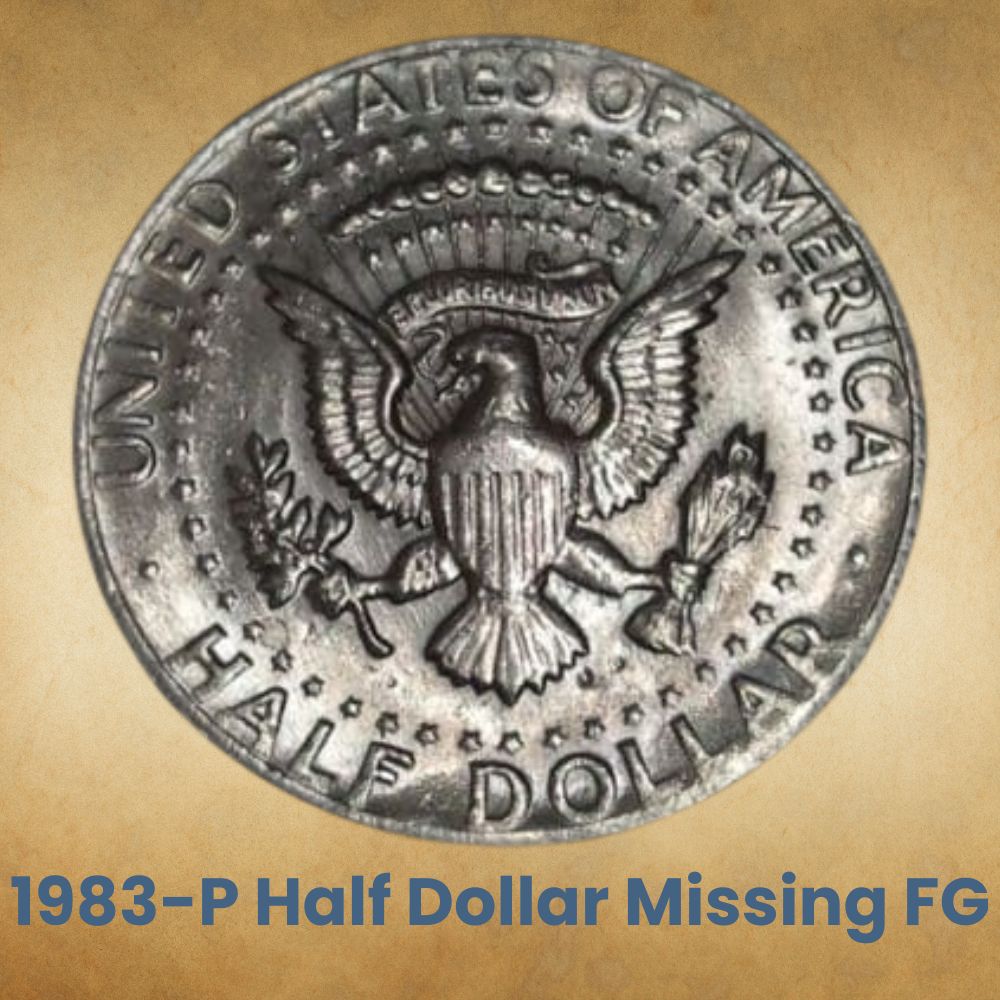
The obverse of the 1983 Half Dollar was designed by Chief Mint Engraver Gilroy Roberts, so it has GR on the cut-off. The reverse was by Chief Mint Engraver Frank Gasparro while he was still an assistant, so his initials, FG, are between the tail and the right leg. On this coin, the FG was accidentally scrubbed off. It’s $15 in AU 50, $45 in MS 63, and $100 in MS 65.
Related Posts: 17 Most Valuable Kennedy Half Dollar Worth Money
History of the 1983 Half Dollar
JFK was the 5th person to appear on a US coin after Abraham Lincoln on the Penny, George Washington on the Quarter, Thomas Jefferson on the Nickel, Franklin Delano Roosevelt on the Dime, and Benjamin Franklin on the Half Dollar. Kennedy replaced Franklin on the Half Dollar for several reasons. While Franklin was a Founding Father, he wasn’t a US President.
And when JFK was assassinated on 22nd November 1963, people wanted him honored on one of the larger silver coins. The $1 rarely circulated, so the options were the Washington Quarter or the Franklin Half Dollar. JFK’s widow – Jackie O – felt it would be disrespectful to displace Washington, so they opted to replace Benjamin Franklin on the 50-cent instead.
The coin had to be produced quickly, so Chief Mint Engraver Gilroy Roberts and his assistant Frank Gasparro teamed up to get it done. They based the coin on the Presidential Medal from 1962, which Kennedy had already approved before his death, so the coin had the added blessing of the man himself. As the story goes, he said nothing when he first saw the portrait.
JFK Coin Approval
This was taken to assume he liked it, and few changes were made to his depiction except for an alteration to his hair, requested by Jackie O. This made it one of the fastest coins ever minted, with just a few weeks between commissioning and coining. Many citizens hoarded the coin when it was released, both for sentimental reasons and financially speculative ones.
After all, 1964 was smack in the middle of the Coin Shortage. Lots of people were stashing coins for their melt value, especially silver ones. By 1965, most coins had switched from silver to clad in response, but the Kennedy Half Dollar stayed silver until 1970. The silver was reduced though, from 90% in 1964 to 40% in 1965. This was done to deter the silver stackers.
By 1983, the Kennedy Half Dollar was a clad coin. By now, all circulating denominations (except pennies and nickels) were minted using the Johnson Sandwich. This meant their core was copper while the outer coin was three-fourths copper and one-fourth nickel. It was introduced by Lyndon Johnson, the 36th US President, to combat the 1960s coin shortage.
By 1970, silver prices had dropped again and people stopped hoarding coins, but the clad cupro-nickel coin was well-established, and it’s still used in the US today. From 2001 to 2021 Kennedy Half Dollars were NIFC, which means Not Intended for Circulation. They weren’t being used much on the streets, so they were mainly minted as proof coins for collectors.
Related Posts: 18 Most Valuable Franklin Half Dollars Worth Money
How to Identify the 1983 Half Dollar?
Numismatics is the study of coins and medals, so numismatists have impressive collections of hard currency. In recent times, they study and accumulate paper money too! Let’s go over some technical terms they commonly use. Coins are minted on blank discs called planchets, with the heads side referred to as the obverse and the tails side referred to as the reverse.
The thin sides as known as edges, and they can either have ridges called reeds or be smooth and/or plain. The raised outer borders are called rims or collars. They help the coin retain its shape while ensuring consistent weight and thickness. The words on a coin are called legends or mottos while the images are called devices and the background is referred to as the field.
The Obverse of the 1983 Half Dollar
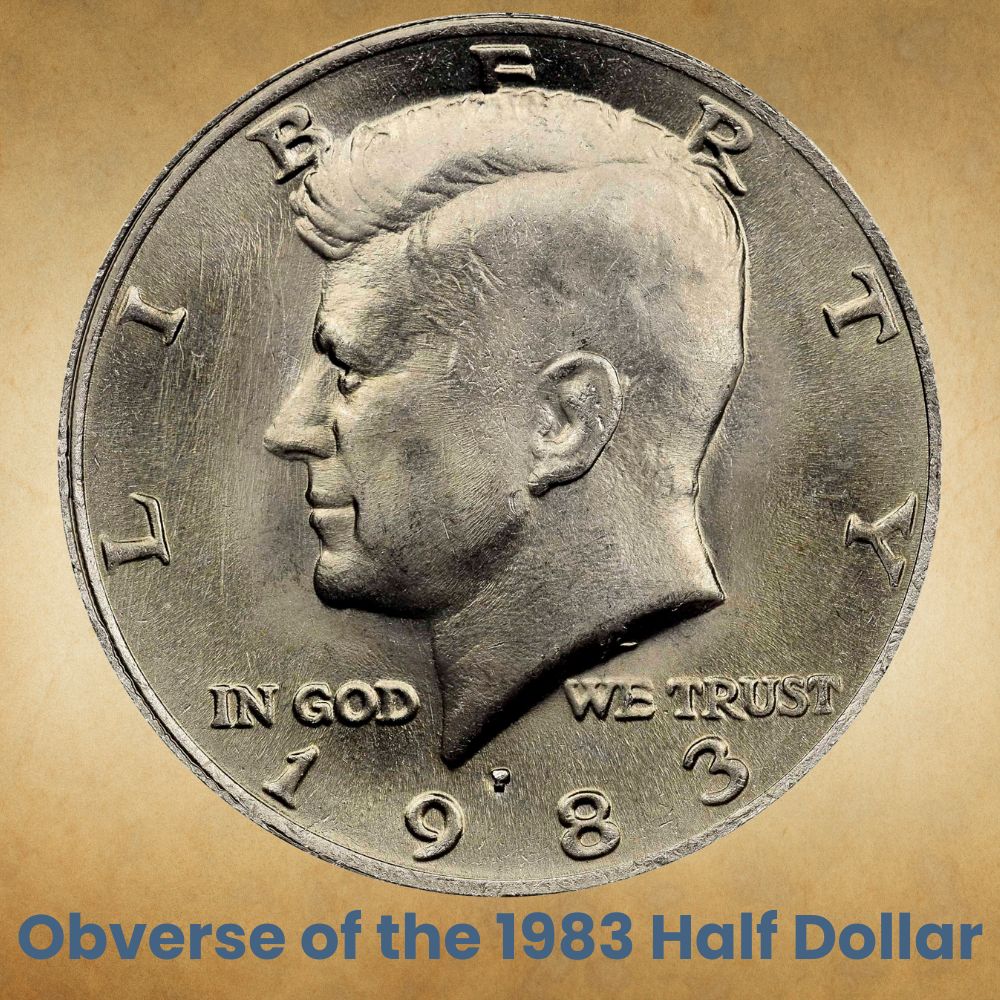
The obverse (heads side) of the 1983 Half Dollar shows a profile of John F. Kennedy facing left. The legend Liberty curves all around JFK’s head, with BER partially covered by his hair. In God is on the left of his neck and We Trust is on the right. Below his neck is the mint mark and mint date, and the designer’s initials, GR, are on the neckline cut-off above the ‘We’.
The Reverse of the 1983 Half Dollar
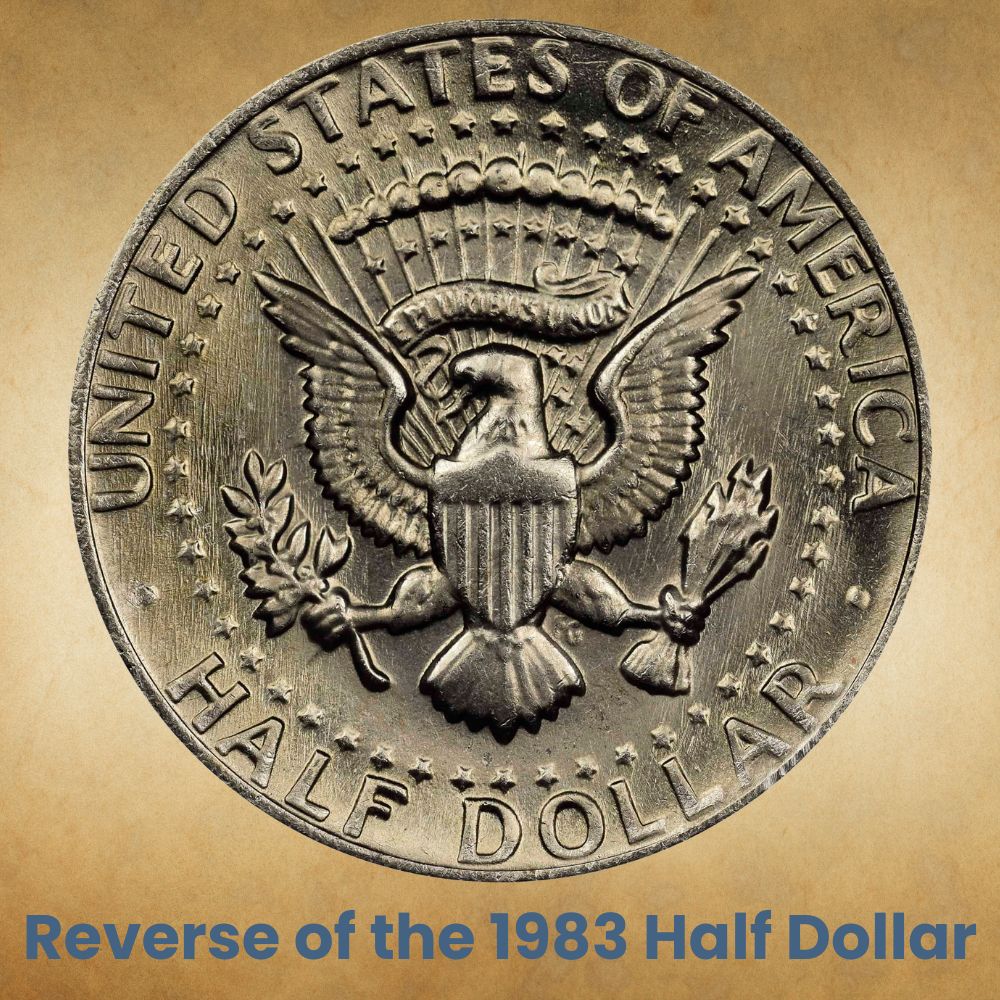
The reverse (tails side) of the 1983 Half Dollar shows the United States Presidential Seal. This seal comprises an eagle with a striped shield on its chest. It has an olive branch in its left talon and a bundle of arrows in its right claw. The eagle holds a sash in its beak that reads E Pluribus Unum. This sash floats over the eagle’s head. FG sits between the tail and right leg.
The seal has multiple symbols in sets of 13 (arrows, stars, clouds, rays of sunlight, etc.) They represent the Original 13 States of the Union. 50 additional stars surround the seal, marking all the 50 states, so the reverse has 63 stars in total. The upper rim of the coin reads United States of America with a dot on either side. The lower rim has the denomination, Half Dollar.
Other Features of the 1983 Half Dollar
The 1983 Half Dollar is 91.67% copper and 8.33% nickel. The coin has a copper core with an outer coating that’s 75% copper and 25% nickel to mimic its original silver composition. This clad version weighs 11.34g, twice the weight of a clad quarter. The coin measures 30.6mm in diameter (1.2 inches) and is 2.15mm thick (0.085 inches). It has 150 reeds along its edge.
Is the 1983 Half Dollar Real Silver?
No. In 1964, Kennedy Half Dollars were 90% Silver, and from 1965 to 1970, they were 40% Silver, but from 1971 onwards, Half Dollars have no silver at all. Instead, they have 8.33% nickel to imitate the silver appearance of earlier coins. The outer layer is 75% copper alloyed with 25% nickel while the inner layer is 100% copper. Nickel also makes the coin harder.
How Much Silver is in a 1983 Half Dollar?
There is no silver in the 1983 Half Dollar. Half Dollars stopped using silver way back in 1971.
